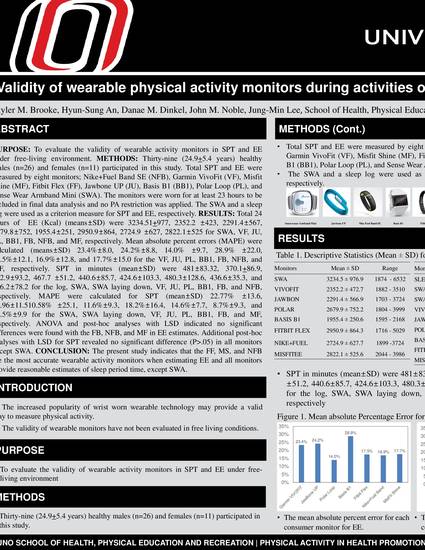
PURPOSE: To evaluate the validity of wearable activity monitors in SPT and EE under free-living environment.
PURPOSE: To evaluate the validity of wearable activity monitors in SPT and EEunder free-living environment. METHODS: Thirty-nine (24.9+5.4 years) healthymales (n=26) and females (n=11) participated in this study. Total SPT and EE weremeasured by eight monitors; Nike+Fuel Band SE (NFB), Garmin VivoFit (VF), MisfitShine (MF), Fitbit Flex (FF), Jawbone UP (JU), Basis B1 (BB1), Polar Loop (PL), andSense Wear Armband Mini (SWA). The monitors were worn for at least 23 hours to beincluded in final data analysis and no PA restriction was applied. The SWA and a sleeplog were used as a criterion measure for SPT and EE, respectively. RESULTS: Total 24hours of EE (Kcal) (means±SD) were 3234.51+977, 2352.2 ±423, 2291.4±567,2679.8±752, 1955.4±251, 2950.9±864, 2724.9 ±627, 2822.1±525 for SWA, VF, JU,PL, BB1, FB, NFB, and MF, respectively. Mean absolute percent errors (MAPE) werecalculated (means±SD) 23.4%±8.0, 24.2%±8.8, 14.0% ±9.7, 28.9% ±22.0,17.5%±12.1, 16.9%±12.8, and 17.7%±15.0 for the VF, JU, PL, BB1, FB, NFB, andMF, respectively. SPT in minutes (mean±SD) were 481±83.32, 370.1+86.9,432.9±93.2, 467.7 ±51.2, 440.6±85.7, 424.6±103.3, 480.3±128.6, 436.6±35.3, and436.2±78.2 for the log, SWA, SWA laying down, VF, JU, PL, BB1, FB, and NFB,respectively. MAPE were calculated for SPT (mean±SD) 22.77% ±13.6,12.96±11.510.58% ±25.1, 11.6%±9.3, 18.2%±16.4, 14.6%±7.7, 8.7%±9.3, and13.5%±9.9 for the SWA, SWA laying down, VF, JU, PL, BB1, FB, and MF,respectively. ANOVA and post-hoc analyses with LSD indicated no significantdifferences were found with the FB, NFB, and MF in EE estimates. Additional post-hocanalyses with LSD for SPT revealed no significant difference (P>.05) in all monitorsexcept SWA. CONCLUSION: The present study indicates that the FF, MS, and NFBare the most accurate wearable activity monitors when estimating EE and all monitorsprovide reasonable estimates of sleep period time, except SWA.
Available at: http://works.bepress.com/danae-dinkel/48/

ACSM 2015